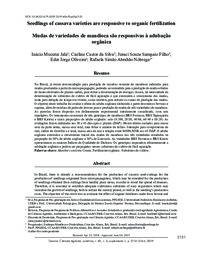Seedlings of cassava varieties are responsive to organic fertilization.
Seedlings of cassava varieties are responsive to organic fertilization.
Author(s): JALA, I. M.; SILVA, C. C. da; SAMPAIO FILHO, J. S.; OLIVEIRA, E. J. de; NÓBREGA, R. S. A.
Summary: In Brazil, there is already a recommendation for the production of cassava seed-cuttings for the production of seedlings originated from micropropagation, which may be extended for the production of seedlings obtained from cuttings from healthy plant stems, in order to avoid the spread of diseases. Therefore, it is essential to establish adequate cultivation substrates of easy acquisition which may stimulate the growth of seedlings, both to reduce the nursery period, as well as the seedling?s production costs. The objective of this work was to evaluate the effect of organic fertilizers made from bovine and goat manures, and tree pruning residues, to produce seedlings of three cassava varieties. The plots were set in a completely randomized design, with six replicates. The treatments consisted of three cassava genotypes (BRS Formosa, BRS Tapioqueira and BRS Kiriris) and five proportions of organic fertilizer: soil (0: 100, 20:80, 40:60, 60:40 and 80:20). The evaluations were performed 30 and 45 days after planting (DAP). There were isolated effects for shoot dry mass, total dry mass, leaf area and number of leaves. Interactions were verified for root length, chlorophyll a and total chlorophyll index, root dry mass and shoot dry mas/root dry mass ratio 45 DAP. The organic fertilizer stimulated the initial growth of cassava seedlings in the three varieties studied in the proportion of 50% of organic fertilizer and 50% of Latosol. Varieties BRS Formosa and BRS Kiriris showed the highest Dickson Quality Scores. Genotypes reacted efficiently to organic fertilization and can be propagated on these easily acquisition cultivation substrates.
Publication year: 2019
Types of publication: Journal article
Unit: Embrapa Cassava & Fruits
Keywords: Cassava, Fertilization (reproduction), Mandioca
Observation
Some of Embrapa's publications are published as ePub files. To read them, use or download one of the following free software options to your computer or mobile device. Android: Google Play Books; IOS: iBooks; Windows and Linux: Calibre.
Access other publications
Access the Agricultural Research Database (BDPA) to consult Embrapa's full library collection and records.
Visit Embrapa Bookstore to purchase books and other publications sold by Embrapa.

